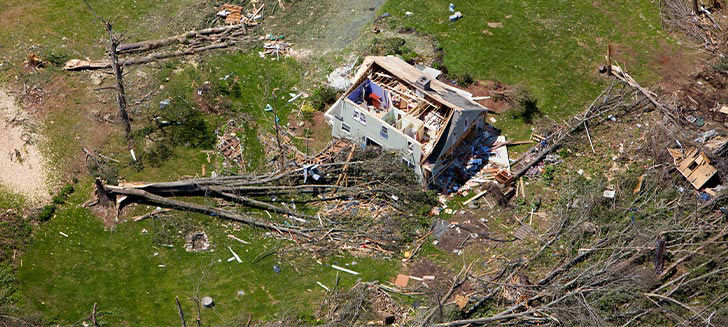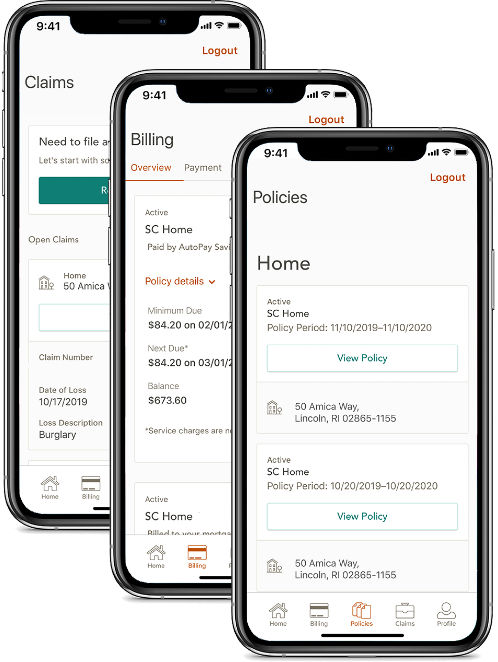Tornado
Be prepared for peak tornado season, from May through July
What is a tornado?
According to the National Weather Service (NWS), a tornado is a violently rotating column of air extending from the base of a thunderstorm down to the ground. Tornadoes are capable of intense destruction, razing buildings, uprooting trees and anything else in their path with winds reaching over 200 mph.
Even if you live outside “Tornado Alley,” the area of the U.S. that runs north from Texas through eastern Nebraska and northeast to Indiana, you’re still vulnerable to tornadoes. As the NWS notes, tornadoes have been reported in all 50 states and can happen at any time, day or night, and at any point in the year.
Signs of a tornado
Deadly tornadoes can occur anywhere with limited warning, so it’s important to be prepared.
Tornado signs to be aware of:
- Dark, greenish sky
- Large hail
- Low-lying clouds, particularly if rotating
- Loud roar, similar to a freight train
Tornado watch vs. tornado warning
A tornado watch means tornadoes are possible, so keep checking for news and updates. A tornado warning means a tornado has been sighted or indicated on radar, so seek shelter immediately.
How to prepare for a tornado
The following tips have been compiled from the NWS and the Federal Emergency Management Agency (FEMA) to help keep you and your home safe and prepared when a tornado is headed your way.
Before the storm:
- Replace gravel/rock landscaping material with shredded bark to reduce risk of damage from wind-borne debris.
- Trim shrubbery and cut weak branches and trees that could fall on your house.
- Develop a family communication plan and practice tornado drills.
- Know your community’s warning system.
- Be aware of weather conditions that spawn tornadoes, especially powerful thunderstorms.
When a storm is coming while you’re at home:
- Turn off utilities, especially natural gas or propane, to avoid fire.
- Consider going to your local emergency shelter if it’s safer to do so.
- Park your car in a garage or next to a building to protect it from wind and flying debris.
- Charge your cell phone and have an emergency supply kit ready.
When a storm is coming as you’re driving:
- Drive to the closest shelter, if safe to do so.
- Don’t try to out drive an oncoming tornado — pull over, park and stay in the car with your seatbelt on and cover your head.
- If you’re outside with no shelter, get lower than the level of the roadway — lie flat in a ditch or depression and cover your head with your hands.
- Don’t seek shelter under an overpass or bridge.
During the storm:
- Stay inside and take cover, ideally in a basement, cellar or an interior room on the lowest floor, away from doors and windows.
- Keep windows closed and doors shut.
- Place infants and young children in car seats, even when indoors.
- Leash your pets or place them in a carrier and keep them with you.
- Get under a sturdy table and use your arms to protect your head and neck.
After the storm:
- Monitor local news and weather before you head outside, and if you’re not at home, return home only when authorities say it’s safe.
- Stay clear of downed wires and evacuate the area immediately if you smell gas.
- Phone systems are often down or busy after a disaster. Text or use social media to communicate if it's not an emergency.
- If you are trapped, cover your mouth with a cloth to avoid breathing dust. Try to send a text, bang on a pipe or wall, or use a whistle first instead of shouting.
- Wear thick-soled shoes, long pants, work gloves and use a flashlight (not candles, in case of gas leak) during clean-up.
- Take pictures of any damage for insurance claims.

Does homeowner insurance cover tornado damage?
The Insurance Information Institute (III) reports that the U.S. experiences more tornadoes than any other country – about 1,000 in any given year.
Tornado damage for homeowners
The damages that result from a tornado — mostly as a result of the intensely strong winds, hail and lightning — are typically covered under your home insurance policy. However, any flood damage wouldn’t be covered by your standard homeowners policy. For total peace of mind, consider purchasing a separate flood insurance policy to keep you better protected.
Tornado damage for condos and renters
Like homeowners policies, condo and renters insurance policies provide coverage for damage caused by the high winds and hail related to a tornado. The difference is in the property covered by these policies.
The property covered by a condo policy depends on the condo association bylaws. The bylaws will describe which property is your responsibility and which property is covered by the condo’s master insurance policy. Your condo insurance applies to portions of the structure that you’re responsible for in addition to your personal property. For more information on what’s covered, you can reach out to your association or contact our representatives to discuss your individual unit’s policy.
Renters policies, on the other hand, provide coverage for your personal property. A renter’s policy doesn’t cover the structure, as you’re not an owner of the property itself.
Tornado damage for cars
Most damage to your car due to a tornado would be covered under your auto insurance policy if you opted to purchase comprehensive (Other than Collision) coverage. Comprehensive coverage provides protection for damage from natural events, such as wind, hail, lightning, falling objects or debris and flooding.
We’re here when you need us
In the event that you suffer damage and need to report a claim, we’re here to help.
Or call us at 800-242-6422


